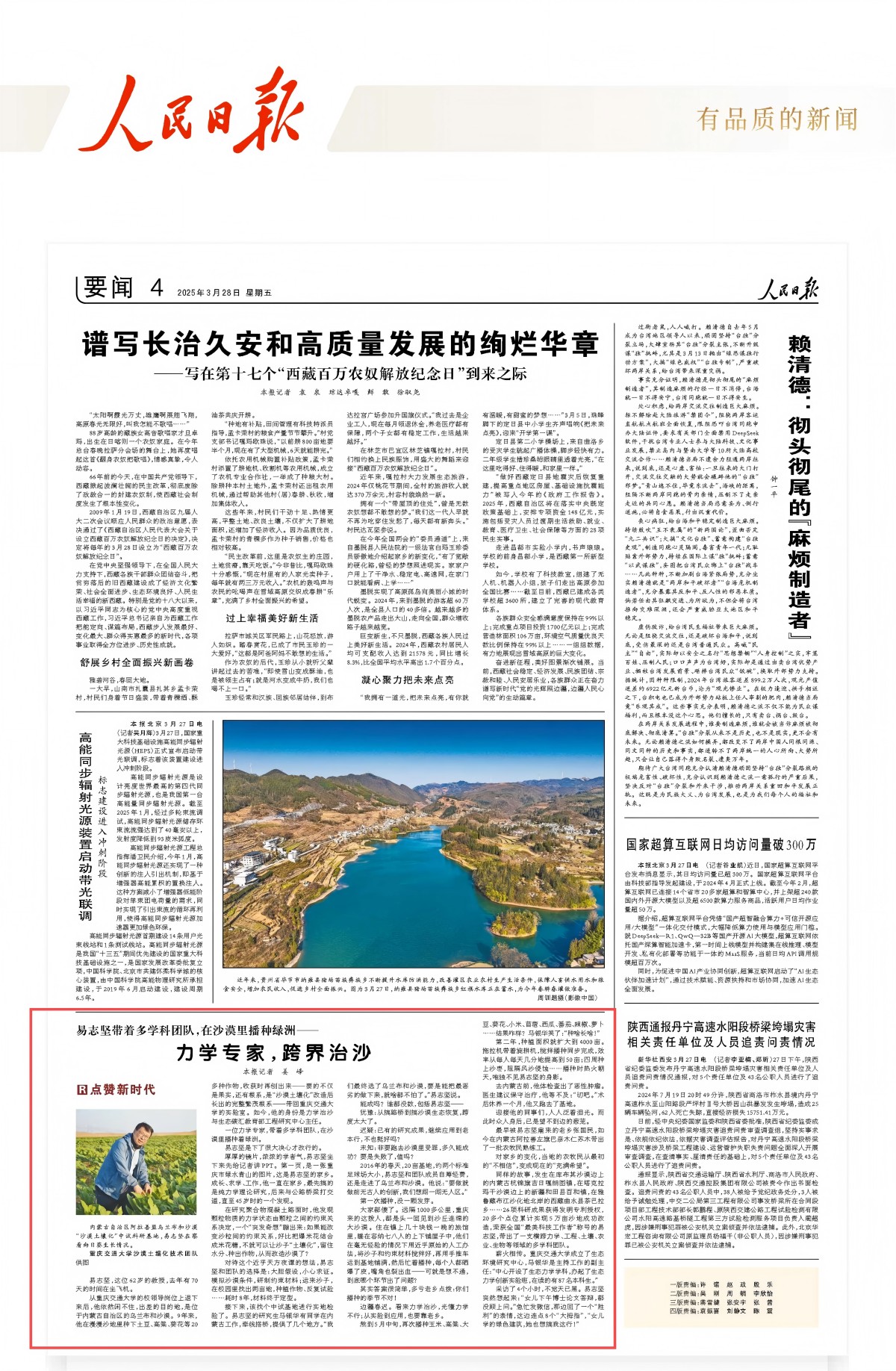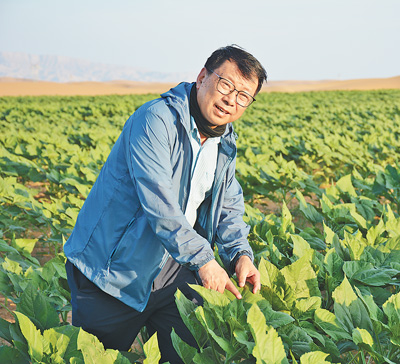Updated: March 28, 2025


This photo shows Professor Yi Zhijian is observing the sunflowers at the desert soilization base in Alxa League, north China's Inner Mongolia Autonomous Region.[Photo/CQJTU]
Yi Zhijian, a 62-year-old professor, frequently flew to desert soilization experiment sites, spending 70 days on airplanes last year.
After retiring from his leadership role at CQJTU, he remained dedicated, frequently traveling to the experiment site in the Ulan Buh Desert, Inner Mongolia Autonomous Region. Over the past nine years, he has led the desert soilization research team in planting more than 20 types of crops—including potatoes, sorghum, and sunflowers—across the vast sandy terrain. At harvest time, Professor Yi digs the crops up, not just for the produce but for the roots—the complete, thriving root systems grown in soilized desert—which he brings back to the university’s lab. Today, he serves as the director of Engineering Research Center of Eco-Mechanical Desertification Control and Ecosystem Carbon Sink.
A mechanics expert leading a multidisciplinary team, Yi is transforming desert into oasis.
Professor Yi’s transition to a new field demanded unwavering resolve.
Yi has a strong scholarly demeanor, wore a thick glasses, he began his interview by presenting a PowerPoint. The first slide showed a lush green landscape in Chongqing, his hometown. Born, educated, and employed there, he initially focused on pure theoretical mechanics before shifting to road and bridge engineering—until a discovery at age 45 changed everything.
While studying polymer concrete pavement, he came to understand that the mechanical state behaviour of granular materials is determined by the constraints between particles. A thought then sparked in his mind: if the constraints between sand particles could be reconfigured—much like turning popcorn into rice crispy treats—might it be possible to soilized sand, enabling it to retain water and nurture plant life, thus turning deserts into arable lands?
Faced with this seemingly far-fetched idea, Yi and his team adopted the approach of “thinking boldly but verifying meticulously.” They developed a binding material, transported sand to the campus, and recreated a desert-like environment. Through repeated planting experiments on a two-acre test site over eight years, they ultimately perfected the material.
Everything was in place—except for one final piece of the puzzle. They needed a on-site testing land. Luckily, Ma Yinhua, Yi’s former graduate student and now Director of the Ecological Environment Research Center, had contacts in Inner Mongolia. They helped scout several potential locations.
“We finally settled on the Ulan Buh Desert,” Yi said. “If we could make crops grow there—one of the harshest environments—we could make it work anywhere threatened by desertification.”
Would it work or not? No one knew the answer to that question, even Yi.
He hesitated, for it was a massive leap to shift from roads and bridges to desert ecological restoration. He wavered, for it seemed safer and more rewarding to continue applying his research to his original field. He couldn’t see the path ahead—wondering: was it worth enduring the hardships of the desert? How long would success take? And what if he failed?
In the spring of 2016, driven by a spirit of discovery, Yi and his team self-funded a 20-acre experimental site—roughly the size of two soccer fields—and ventured into the Ulan Buh Desert. “We wanted to explore uncharted territory. If we’re going to innovate, let’s do something unprecedented,” he said.
However, the first planting experiment failed to produce even a single sprout.
Everyone was thunderstruck—and deeply frustrated. Over 1,000 kilometers from home, these Chongqing natives were facing endless sand dunes for the first time. As for living conditions, they stayed in budget motels, crammed into rooms with eight-person bunk beds. When it came to the experiments, they mixed sand and binding materials by hand, hauled them in wheelbarrows, and painstakingly sowed seeds beneath the scorching sun. Their skin peeled; their lips cracked and bled—yet they still couldn’t figure out what had gone wrong.
The reason, as locals pointed out, was that they chose the wrong time for seeding.
Spring arrives late on the northern frontier of China. As it turned out, desertification control through mechanical methods required more than just theories—it needed local wisdom, too.
By mid-May, the team tried planting again, sowing corn, sorghum, soybeans, sunflowers, millet, alfalfa, watermelons, tomatoes, peppers, radishes, and several other crops. Finally, Ma Yinhua grinned, “Everything we planted was sprouting!”
The following year, the planting area expanded to 4,000 acres. Tractors equipped with rotary tillers streamlined the process of mixing and sowing, boosting efficiency from just a fraction of an acre per person per day to 50 acres. They also planted sea buckthorn bushes to serve as windbreaks.
The planting fields buzzed with activity—but Professor Yi wasn’t there.
In fact, before heading to Inner Mongolia, Yi had been diagnosed with a malignant tumor. Doctors recommended starting with conservative therapy, but Yi insisted on surgery. Just one month after the operation, he rushed back to the desert.
The team welcomed him with tears in their eyes—and behind them stretched lush, endless greenery.
Zhang Guomin, one of the first locals worked at the planting site, now leads a team of skilled farmers and herders in Bayan Muri Sumu, Alxa Left Banner, Inner Mongolia—the site of the original planting experiment.
Local herders and farmers, who were once skeptical of desert soilization technology, now see hope in the soilized desert.
Similar stories have unfolded in Jiri Galangtu Town near the Kubuqi Desert, Baihe Town near the Taklamakan Desert, and Chabalaxiang along the northern bank of the Yarlung Tsangpo River. With over 50,000 acres of desert successfully restored across 20 sites and 26 research patents secured, Yi was honored as one of China’s “Most Outstanding Scientists.” He has built a multidisciplinary team spanning mechanics, engineering, soil science, agriculture, and biology.
To further advance research in desert soilization technology and strengthen efforts in desertification control and ecological restoration, CQJTU has established an Ecological Environment Research Center, with Ma Yinhua serving as deputy director. “We’ve launched an eco-mechanics discipline and an innovation program, with 87 undergraduates enrolled,” Ma said.
As night fell over the Ulan Buh Desert, the four-hour interview came to an end, and Yi suddenly remembered that his daughter had her PhD defense that day. “My daughter had her PhD defense this afternoon—I forgot to ask how it went!” he said, quickly sending her a message. Moments later, joyfully, he received her reply, complete with a “victory” emoji.
Replying back eight “thumbs up” emojis, Yi beamed, “my daughter studies green architecture and wants pursue the same kind of work as me.”
Source:
人民日报:https://www.peopleapp.com/column/30048638124-500006168963